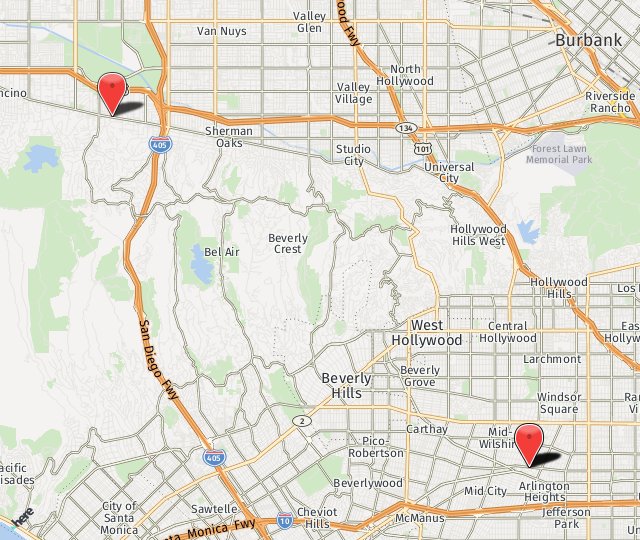MCL Sprain (Medial Collateral Ligament)
The collateral ligaments are located on the sides of the knees. The medial collateral ligament (MCL) is located in the knee, connecting the inner side of the thigh bone to the shin (tibia) bone. The MCL helps the knee to resist force and keeps it stable against unusual movement. The collateral ligaments also control the sideways motion of the knee. This ligament may become torn or damaged as a result of direct impact to the outside of the knee. An injury may cause the MCL to loosen, stretch and possibly tear, resulting in pain and inflammation.
Symptoms of an MCL Sprain
Patients with an MCL sprain may experience the following symptoms on the inside of the knee:
- Pain
- Tenderness
- Swelling
After an MCL sprain, individuals may also experience, instability, or the feeling that the knee is going to give way.
Types of MCL Sprains
An MCL sprain is diagnosed through a physical examination of the knee. Additional imaging tests may include an X-ray or MRI scan. The doctor determines the grade of the MCL sprain based on the extent of damage, which may range from a mild tear to a complete rupture. MCL sprains may be classified as:
- Grade 1 sprains occur when the ligament is mildly damaged
- Grade 2 sprains occur when the ligament has been stretched and loosened
- Grade 3 sprains occur when the ligament is completely torn
- Grade 2 sprains are commonly referred to as a partial tear of the ligament.
Treatment of an MCL Sprain
Treatment for an MCL sprain varies based on the severity of the injury, but it can normally be treated with conservative methods that include:
- Rest
- Ice
- Compression
- Elevation
- Knee brace
A physical therapy program may help to strengthen and restore function to the knee. In severe cases, when the ligament has torn completely and not healed properly, surgery may be necessary for repair.
LCL Sprain (Lateral Collateral Ligament)
The collateral ligaments are located on the sides of the knees. The lateral collateral ligament (LCL) is located within the knee joint, connecting the outer side of the thigh bone (femur) to the fibula, the smaller bone in the lower leg. The LCL provides strength and stability to the joint and helps the knee to resist force and stay stable during unusual movement. The collateral ligaments also control the sideways motion of the knee. This ligament may become torn or damaged as a result of direct impact or force that may push the knee sideways. An injury may cause the LCL to loosen, stretch, and possibly tear, resulting in pain and inflammation on the outer part of the knee. An LCL sprain commonly occurs in athletes who participate in collision sports such as rugby and football.
Symptoms of an LCL Sprain
Patients with an LCL sprain may experience the following symptoms on the outside of the knee:
- Pain
- Tenderness
- Swelling
After an LCL sprain, individuals may also experience, instability, or the feeling that the knee is going to give way.
Diagnosis of an LCL Sprain
An LCL sprain is diagnosed through a physical examination of the knee. Additional imaging tests may include an X-ray or MRI scan. Imaging tests allow the doctor to see whether the injury is associated with a broken bone as well as get a more accurate view of the injury to determine treatment.
Types of LCL Sprains
The doctor determines the grade of the sprain based on the extent of damage, which may range from a mild tear to a complete rupture. LCL sprains may be classified as:
- Grade 1 sprains occur when the ligament is mildly damaged
- Grade 2 sprains occur when the ligament has been stretched and loosened
- Grade 3 sprains occur when the ligament is completely torn
When the lateral collateral ligament is injured, other structures within the joint are commonly injured as well.
Treatment of an LCL Sprain
Treatment for an LCL sprain varies based on the severity of the injury, but it can normally be treated with conservative methods that may include:
- Rest
- Ice
- Compression
- Elevation
- Knee brace
Individuals are advised to avoid any exercise or physical activity for several weeks after the injury to ensure complete healing. As the ligament heals, a physical therapy program may help to strengthen and restore function to the knee. In severe cases, when the ligament has torn completely and not healed properly, surgery may be necessary for repair.
Schedule a MCL or LCL Sprain Consultation
Make an appointment with a Medial (MCL) or Lateral Collateral Ligament (LCL) specialist who will review all the details about this procedure and answer any questions or concerns you may have before proceeding. Call our Los Angeles office at 323-551-9826 or our Encino office at 323-551-9826 or complete an online contact form and our office will be in touch with you shortly thereafter. Thank you for choosing Arash A. Dini, MD in Southern California, we look forward to seeing you!


